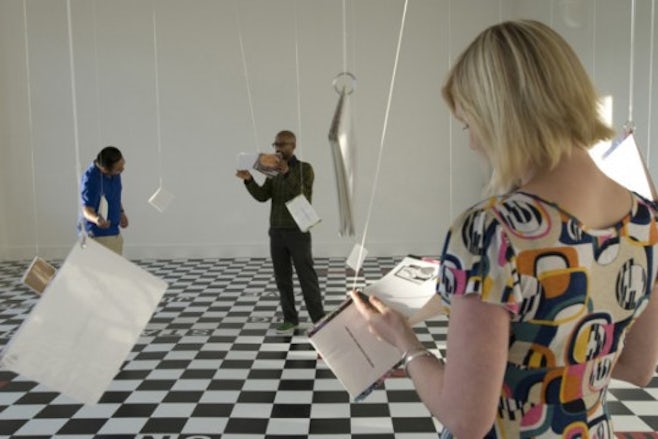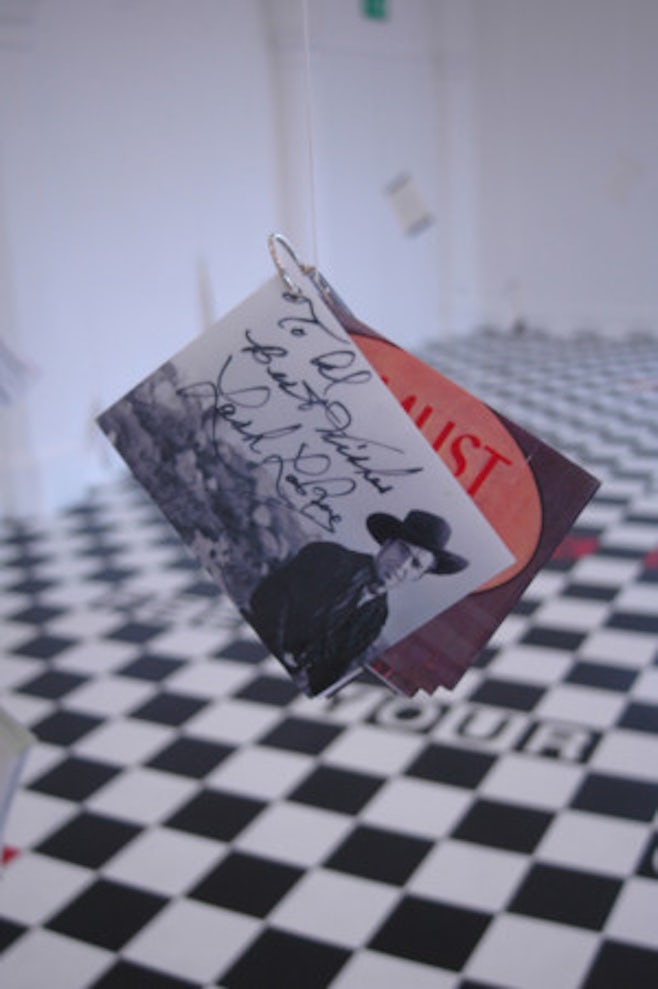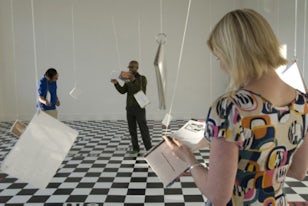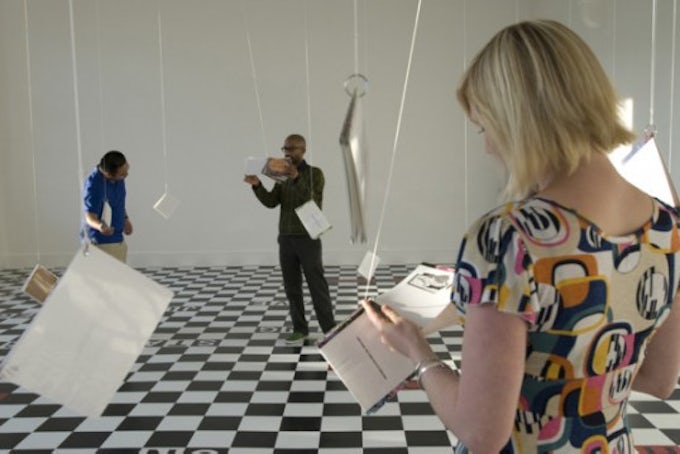
‘Art should be familiar and enigmatic, just as human beings themselves’, wrote Allen Ruppersberg in his 1985 Fifty Helpful Hints on the Art of the Everyday.01His recent solo exhibition on at the Camden Arts Centre (2008) similarly operates between the mundane and the mysterious. Comprising two large installations based on his extensive personal archive, the show combines Americana and riddles, vinyl letterings and fragments of poems, articulating some of his key concerns: the investigation of the formal potential of the written word, the mechanisms of story-telling, and the creation of alternative ways to engage with language and artworks.
Artists’ libraries or archives, and indeed any personal collection of printed material, are often fascinating because they reveal – or give the impression of revealing – their owners’ most intimate facets. The outcomes of acquisition processes that involve education, intellectual interests, random purchases and presents, each is a unique assortment of knowledge that somehow mirrors its possessor’s life. When in 2006 Martha Rosler showed her personal library at e-flux’s New York space, she shared with her audience the landmarks of her intellectual formation. She invited them to discover, and perhaps appropriate, some of the crucial texts of her development as a person, an artist and a critic.
Ruppersberg’s pieces on show recently at the Camden Arts Centre, and especially the series of laminated pamphlets taken from his archive that make up The Book Circus(2008), also draw on this sense of proximity. The visitors are encouraged to dip into the artist’s immense collection, which, according to Allen McCollum,02includes thousands of books, postcards, magazines, films, slides, comics and images of all sorts. Like Rosler’s library, The Book Circus is an introduction to the artist’s world. This emphasis on the personal is a recurrent feature in Ruppersberg’s practice, perhaps best illustrated in his The New Five Foot Shelf(2001), which has successively taken the form of a sculptural installation of leather-bound books and large-scale photographs of the artist’s studio, a soft-cover distributed for free at the Ljubljana biennial in 2003 and a website. 03 For this multifaceted piece, Ruppersberg appropriates the format of the 1910 Harvard ClassicsDr Eliot’s Five Foot Shelf of Books, which brought together an essential library for the cultivated man. Opposed to this generalist aim, Ruppersberg’s version is strictly individual, assembling, amongst others things, extracts from notebooks, reference books by the artist’s main influences and newspaper obituaries. Like Rosler’s library, The New Five Foot Shelf denies the virtue often granted to the idea of universal knowledge; it is a position taken for the sake of subjectivity.
There are key differences between the two artistic processes: whereas Rosler chose to display her entire library, Ruppersberg always discloses only a fraction of his collection. Rather than sharing a personal database, each work –The Book Circus and The New Five Foot Shelf are only two of many examples – is a meticulous compilation, offering a particular perspective on his own archive. Viewers are never given access to the work in totality; Ruppersberg instead conceals as much as he reveals, willingly maintaining a distance with his audience and preserving for his work the possibility of its developing further. Perhaps a more significant difference between the two artists’ approaches to the library is that Ruppersberg, unlike Rosler, exploits the material’s form as much as its content. This is obvious in the multiplicity of formats that The New Five Foot Shelftakes, or in The Book Circus, in which the booklets are suspended to a large ring attached to the ceiling to make an oversized hanging mobile. In Ruppersberg’s hands, the collection isn’t just transformed by drastic selection; it is also physically turned into a new formal entity, into an artwork that extends the potential of printed material.
If this process of selection can be understood as Ruppersberg’s method on a macro level, the artist also operates within the textual fabric of the collection, exploring in his works the possibilities of the written word and the mechanisms of narration. In The Book Circus most of the booklets gather 1960s-style children’s book illustrations, reproduced and recomposed to form compellingly fragmented narratives. Sometimes a riddle makes for an unexpected conclusion: ‘As you are now so once was I / as I am now so you must be / prepare for death and follow me’. Other pamphlets use different combinations of visual and written material: Once Upon a Time in Southern California, LA in the ’70s enunciates in short type-written sentences the local legend of John Dominic Caretto’s Spanish canteen. Each page is followed by the seemingly bland black-and-white photograph of an anonymous American diner. Beside the appealing poetic of the text/image confrontations, these anonymous shots seem to complete the story, to hint at untold events about to happen or already finished; they provide a dry narration with an extra depth of meaning. Yet like Rosler’s piece The Bowery in two inadequate descriptive systems (1974-75), which juxtaposes images of the Bowery neighbourhood with list of words used to described drunkenness and destitution, Once Upon a Time in Southern Californiaprobes into the inadequacy of images and text as communication tools. The conversation between words and photographs is often just a projection of the reader’s mind. Both works highlight the irrational urge to bridge the linguistic and the visual, to ‘make sense’ of disparate elements.


Like The Book Circus, Reading Standing Up(2004-08), the second work on display at Camden, combines words in evocative assemblages, but the focus is less on the narrative process than on words’ sensorial qualities. At odds with everyday relationships to the written word, often characterized by quiet interiority, Reading Standing Up physically engages visitors; it invites a direct, almost sensual, involvement with writing. The gallery floor is transformed into a dizzying chessboard by black-and-white PVC tiles, where words written in negative (white on black, black on white) spell out snippets of Dadaesque poetry under the viewers’ footsteps: ‘Eye or mind – one – two – Italy or France – riddle or poem – or the choosy business of art.’ This work strikingly resembles Ruppersberg’s floor piece Letter to a Friend (1997) – on which he listed the names of his artist friends who had died during that year – but the piece on show in London perhaps has more to do with Ruppersberg’s ongoing series of brightly coloured posters, which freely mingle his own slogan-like writing and the work of other poets with announcements borrowed from some of his printer’s clients (Ruppersberg has been using the same printer of commercial advertising posters, Colby Poster in Los Angeles, since 1983). These posters are often displayed side by side, from floor to ceiling in a psychedelic arrangement of jarring hues and words. As in Reading Standing Up, viewers are swallowed by the huge graphic landscape, unable to take in the full picture all at once, instead immersed, almost belittled, by a text expending far beyond their reach, and reduced to painstakingly picking up fragments of sentences one by one.
Like those of many American artists of his generation, from Ed Rusha to Lawrence Weiner, Ruppersberg’s practice investigates alternative distribution channels for art. Books and posters, easily and cheaply circulated – and often available for free in his exhibition – allow him to bypass the money-based system that conditions art collecting. But his artistic strategy is not only an attempt to reach beyond the confined audience of museums and galleries; it springs from the artist’s attempt to share directly with his audience, and to set up what he calls an ‘aesthetic of giving away’. The Camden Arts Centre exhibition illustrates the same desire to generate more and new ways of relating to artworks, not only based on contemplation, but also on intellectual, physical and emotional interaction.
– Coline Milliard
Footnotes
-
Allen Ruppersberg, Fifty Helpful Hints on the Art of the Everyday in ‘The Secret of Life and Death’, exh. cat. (Los Angeles Museum of Contemporary Art and Santa Barbara: Black Sparrow Press, 1985). Quoted in Allen McCollum, Allen Ruppersberg: What One Loves About Life are The Things That Fade, originally published in AL RUPPERSBERG: BOOKS, INC, exh. cat. (Frac Limousin, France, 2001).
-
A. McCollum, Allen Ruppersberg, op. cit.
-
Realised in collaboration with the Dia Art Foundation, New York.
